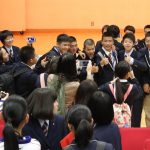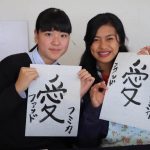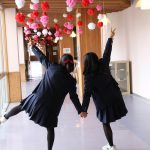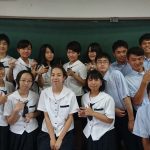History
Timeline of our School
| 1901(M34)*1 | KUNORI, Tomi (Ms.) founds a girls’ sewing school in Yonezawa City. This was later to become Kunori Gakuen Senior High School. |
| 1903(M36) |  With the dramatic increase in the number of students, the first school buildings of the then Kunori Girls’ Sewing School are completed. With the dramatic increase in the number of students, the first school buildings of the then Kunori Girls’ Sewing School are completed. |
| 1922 (T11)*2 |  With the establishment of a teacher training course, graduates start to become home economics teachers in the area. With the establishment of a teacher training course, graduates start to become home economics teachers in the area. |
| 1935(S10)*3 | The new school buildings are completed in October on the site where the school still lies. |
| 1945(S20) | The end of World War 2. |
| 1947(S22) | The school is re-named Yonezawa Girls’ Senior High School. |
| 1962(S37) | The school slogan becomes “Dignity, Dedication and Harmony.” |
| 1981(S56) | The 80th anniversary of the founding of the school is celebrated. |
| 1982(S57) | In recognition of the long service of Yonezawa Girls’ Senior High School, the school is awarded the Ai no Hato Prize by Yamagata TV. The Kunori Education Research Center is set up and opened to the greater community in the area. |
| 1988(S63) | Kunori Gakuen Senior High School begins its academic year of two semesters, the first being from April to September and the second from October to March. |
| 1995(H7)*4 | With the implementation of the five-day school week at national level, Kunori Gakuen Senior High School established its Kunori Saturday School. Also, Kunori Gakuen Senior High School’s Education Consultation Room is set up. |
| 1997(H9) | The wooden structure of Kunori Gakuen Senior High School is recognized as a historical scene and, as such, is registered as a tangible cultural asset. |
| 1999(H11) |  The new school building extension is completed. And the school’s name is amended from Yonezawa Girls’ Senior High School to Kunori Gakuen Senior High School and the process allowing boys to enroll into Kunori Gakuen Senior High School begins. The new school building extension is completed. And the school’s name is amended from Yonezawa Girls’ Senior High School to Kunori Gakuen Senior High School and the process allowing boys to enroll into Kunori Gakuen Senior High School begins. |
| 2000(H12) | The Year to Encourage Childrens’ Reading is marked with various school library activities and Kunori Gakuen Senior High School is officially recognized for its efforts by the Ministry of Education. |
| 2001(H13) | The school celebrates the 100th anniversary of its establishment. |
| 2005(H17) | Students begin to study in either of two courses, one being the Progress Course in which students study with the particular purpose of going to third level education, the other being the Universal Course in which students study with various careers in mind. |
| 2011(H23) | An earthquake of magnitude 9 hits the Northeastern coast of Japan causing devastation. Many of our school’s staff members and graduates suffer losses. Many people who lost their homes come to Okitama, the area in which our school is located and our students helped in various volunteer activities. |
| 2015(H27) | Our school is recognized as a Super Global High School Associate School by the Ministry of Education, Culture, Sports, Science and Technology. We continue to teach our students highlighting global issues. In order to prepare them for the ever increasingly global world we live in. |
*1: Emperor Mutsuhito reigned Japan for the 45 years between 1868 and 1912, and the period of his reign is known as the Meiji period. Japanese people use “M1” to refer to the first year of the Meiji period, M2 to the second year, etc.
*2:Emperor Yoshihito reigned Japan for the 15 years between 1912 and 1926, and the period of his reign is known as the Taisho period. Japanese people use “T1” to refer to the first year of the Taisho period, T2 to the second year, etc.
*3:Emperor Akihito reigned Japan for the 64 years between 1926 and 1989, and the period of his reign is known as the Showa period. Japanese people use “S1” to refer to the first year of the Showa period, S2 to the second year, etc.
*4:Emperor Akihito’s reign began in 1989 and the period of his reign is currently known as the Heisei period. Japanese people us “H1” to refer to the first year of the Heisei period, H2 to the second year, etc.








